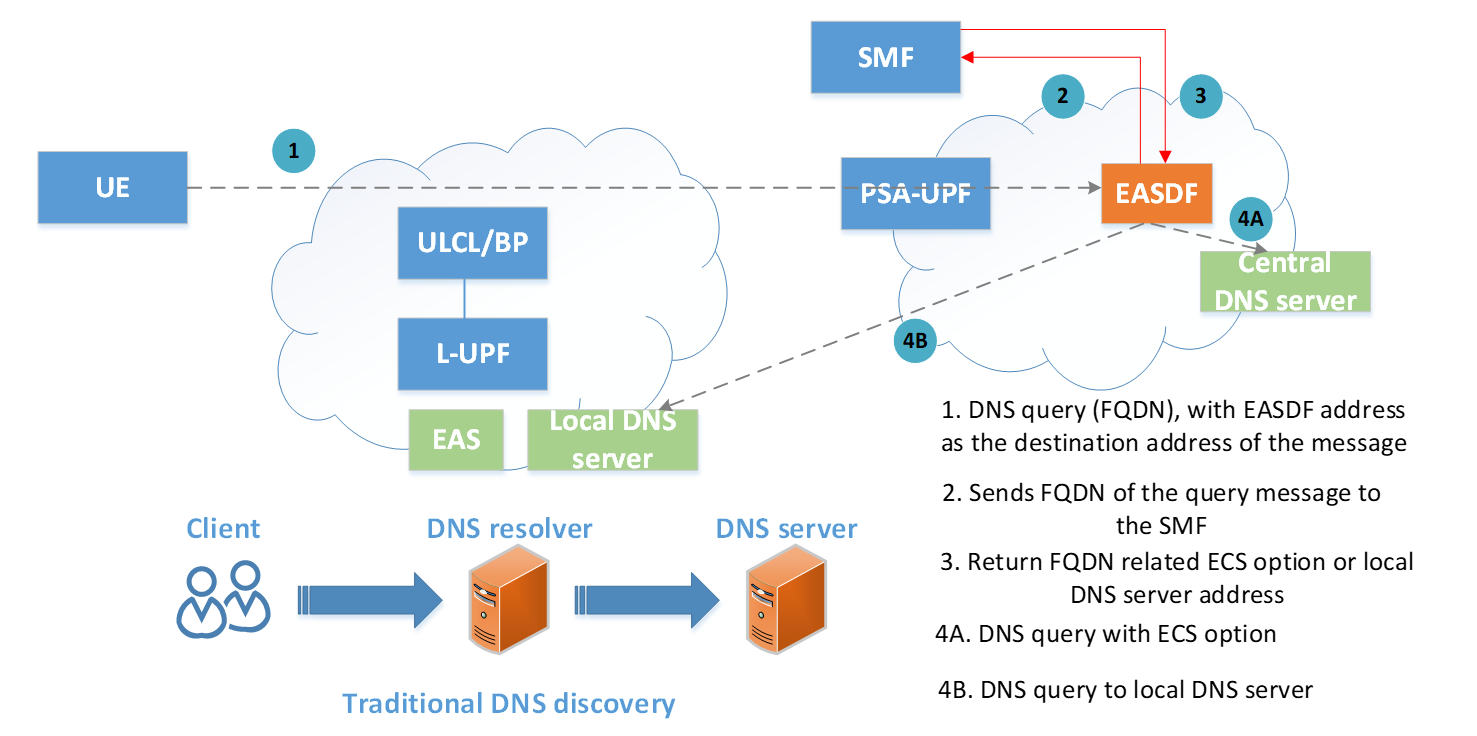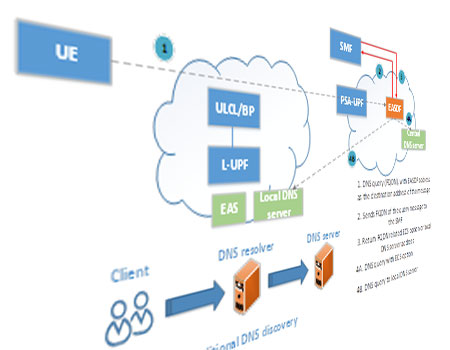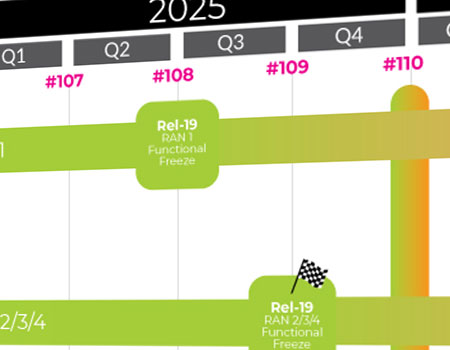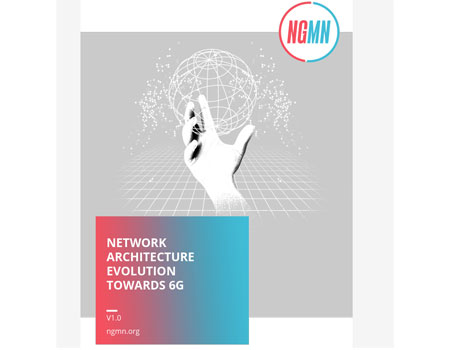By Caixia QI (WI rapporteur), Christian Herero-Veron (Huawei)
First published December 2024, in Highlights Issue 09
Though the 5GS supports Edge computing since day one of Release 15, 3GPP provides Edge computing (EC) specific enhancements from Release 17 onwards. In addition, Release 18 - the first release of 5G-Advanced (5GA) - brings roaming improvements to support access to the edge home environment (EHE) in a visited PLMN. Release 19 will bring further enhancements for Edge Application Server (EAS) discovery and re-discovery and User Plane Function (UPF) selection and re-selection and reduce the impact on central 5GC network function (NF).
All this is done with the additional focus of providing cutting-edge native use cases and applications, like augmented reality (AR)/extended reality (XR), autonomous vehicles & vehicle-to-everything (V2X) communications and other metaverse or virtual environments.
From the outset, the 5G architecture allows cloud-native applications to support edge compute use cases without any edge infrastructure awareness. However, the 5GS does not provide the possibility for user equipment (UE) to discover edge applications (IP addresses). This is accomplished at the application layer by using, for example, domain name servers (DNS). Furthermore, though the 5GS offers mechanisms to handle data traffic (user plane UP) and redirect it towards the correct applications (EC applications), there is no particular handling of Edge computing.
In Release 17, the 3GPP Core-network and Terminals (CT) working groups added protocol support for a new network function of the 5G architecture called edge application server discovery function (EASDF). The EASDF supports session breakouts (i.e., forwarding domain name service (DNS) traffic based on FQDNs of DNS Query messages) by providing edge application server (EAS) which is closer to the UE physical location. The EASDF also provides EAS information such as EAS IP addresses or AS FQDNs in the received DNS Response message to the session management function (SMF) to trigger the local PDU session anchor (L-PSA)/UPF insertion for dynamic steering of edge application traffic.
Figure. EAS discovery procedure
The 3GPP CT WGs also added the possibility for network operators setting forwarding rules of EC data traffic (user plane UP). The policy and charging function (PCF), which manages the traffic rules, provides the SMF with user-plane latency requirements by using policy and charging control (PCC) rules. Then, the SMF uses these rules to detect data packets and decide where to forward them to meet quality of service (QoS) requirements, the SMF may perform PSA/UPF relocation if the target PSA/UPF cannot satisfy the maximum UP latency. The PCF also authorizes UP latency requirement so the PCF checks whether the application function (AF) has an authority to make a request on UP latency requirements.
In short, the 5GS offers not only discovery of edge application but also mechanisms to handle data traffic of edge applications (user plane UP) and redirect it towards the correct applications ensuring secure authentication and consistent QoS.
The UE sees the EASDF as a DNS resolver for edge application servers (EAS) so that the UE discovers the IP address of an edge application. The procedures supported from the UE side are EAS (re)discovery and edge configuration server (ECS) address configuration information provisioning.
All starts at protocol data unit (PDU) session establishment procedure where the UE sends a request which indicates to the SMF the support of EC enhanced features; EAS (re)discovery support, edge DNS client (EDC) support, and ECS configuration information provisioning support. The SMF is the entity in the PLMN which performs EAS discovery. The SMF selects the EASDF and provides its IP address to the UE as the DNS server to be used for the requested PDU session. Also, the SMF can provide the IP address of the local DNS server (to resolve application server FQDNs) to the UE as the DNS server to be used for the PDU session. The SMF may select an uplink classifier branching point (ULCL/BP) (based on PCC rules from the PCF pushed by, e.g., the AF) and a L-PSA/UPF for the PDU session.
The SMF can decide to select a new EASDF, for example, if the UE changes its location or network resources are not sufficient. In order to trigger EAS rediscovery (i.e., to provide updated DNS server address(es) due to the newly selected local DNS server or the newly selected EASDF), the SMF uses the network-requested PDU session modification procedure so that the UE obtains new EAS rediscovery information.
In addition to enhance the 5G architecture, the 3GPP CT WGs have developed the interactions towards the application layer architecture for EC defined by SA6 and compatible with the multi-access edge computing (MEC) architecture developed by ETSI (ETSI MEC Framework Specification). The edge configuration server (ECS) may be in the PLMN or in the edge computing service provider (ECSP; mobile network operator (MNO) or 3rd party service provider) and provides functions for the edge-enabled client (EEC) residing in the UE to connect with an edge enabler server (EES).
3GPP CT WGs have therefore added the provisioning of ECS configuration information from the SMF to UEs. This configuration information may contain ECS addresses corresponding to different ECSPs and spatial validity conditions; geographical service area, a list of TA(s) or a list of countries (list of MCCs).
In Release 18, further enhancements are added to support access to EHE when roaming (in a VPLMN) including improved network exposure of UE traffic related information to common EAS via local PSA/UPF. Also, support for offload policies to match more granular sets of UEs without exposing operator-internal configurations to ECSP AFs, solutions to influence PSA/UPF and EAS (re)location for collection of UEs are added. There are also solutions to avoid the UE to switch the EC traffic away from the EC PDU session and the 5GS altogether (due to conflicting connectivity preferences in the device). Finally, the ECS provisioning information has also been enhanced by optionally provide ECS authentication methods to the UE.
You will need to dig deeper. Start here:
| Title | |
| CP-212021 | CT aspects of support for Edge Computing in 5G Core network (eEDGE_5GC) |
| CP-241027 | CT aspects of Edge Computing phase 2 (EDGE_Ph2) |
| CP-242026 | New WID on CT aspects of enhancement of support for Edge Computing in 5G Core network - Phase 3 (eEDGE_5GC_Ph3) |
| TS 29.514 | 5G System; Policy Authorization Service; Stage 3 |
| TS 22.261 | Service requirements for the 5G system |
| TS 23.501 | System architecture for the 5G System (5GS) |
| TS 23.502 | Procedures for the 5G System (5GS) |
| TS 23.503 | Policy and charging control framework for the 5G System (5GS); Stage 2 |
| TS 23.548 | 5G System Enhancements for Edge Computing; Stage 2 |
| TS 23.558 | Architecture for enabling Edge Applications |
| TS 24.008 | Mobile radio interface Layer 3 specification; Core network protocols; Stage 3 |
| TS 24.501 | Non-Access-Stratum (NAS) protocol for 5G System (5GS); Stage 3 |
| TS 29.502 | 5G System; Session Management Services; Stage 3 |
| TS 29.503 | 5G System; Unified Data Management Services; Stage 3 |
| TS 29.508 | 5G System; Session Management Event Exposure Service; Stage 3 |
| TS 29.510 | 5G System; Network function repository services; Stage 3 |
| TS 29.512 | 5G System; Session Management Policy Control Service; Stage 3 |
| TS 29.513 | 5G System; Policy and Charging Control signalling flows and QoS parameter mapping; Stage 3 |
| TS 29.522 | 5G System; Network Exposure Function Northbound APIs; Stage 3 |
| TS 29.556 | Edge Application Server Discovery Services; Stage 3 |



 Technology
Technology



